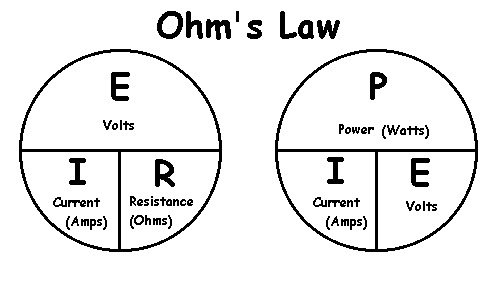The diagrams below are simplified illustrations to show the algebraic equivalent of three possible equations each. Using the diagram on the left as an example, you have the following possibilities:E = I x R
I = E ÷ R
R = E ÷ I
You can use the Ohm's Law calculator to figure any unknown value as long as you have two known values to work with. For example, if you want to know how much current a 100 watt lamp in a 12 volt circuit will draw, you can calculate it easily because you already have two values; 100 watts (P /power) and 12 volts (E). As indicated in the circle on the right, power is divided by either current (I) or voltage (E) P ÷ E = I. Therefore the equation would be written as follows: 100 ÷ 12 = 8.333 amps.
Now if you were curious (for what ever reason) as to how much resistance (R) this 100 watt lamp offered to the same circuit, you would use the circle on the left. It indicates that resistance (R) is found by dividing the voltage (E) by the current (I) E ÷ I = R. You have already determined the current of the lamp in the first step, so you would take that value and write the equation as follows: 12 ÷ 8.333 = 1.44 ohms (darn near a short! ...Guess that's why it glows so bright!). As you can see, any unknown value can be found by using any combination of the Ohm's Law diagrams.
If you were calculating the current for auxiliary lights, all you need to do is multiply the amps you calculated by the number of lamps you are planning to install and you will have the total current draw. Bear in mind that because you will be using these at night, you will have to add the current of the headlights (on high beam), so if you have high powered H4s, you can use Ohm's Law to determine their amperage. Remember it might also be cold and raining, so better add the heater and windshield wipers too, these can be estimated by the fuse rating of their circuits. If you have a CB add another 8 amps to be safe. The sum of all these will be the total draw of your accessories under worst case conditions. It is best to always leave yourself a 25 amp margin to insure that there is enough power for your fuel pump, computer and engine management system, and your battery can have whatever is left over to keep it at full charge (just in case you stall it out in the boonies after hours of four wheeling on a cold rainy night).
Back to Craig's Jeep page Back to Tech Page Back to Electrical Page
Questions or comments may be sent to:
dch@olypen.com

A Wizard of Wiring
Production
WoW
®
